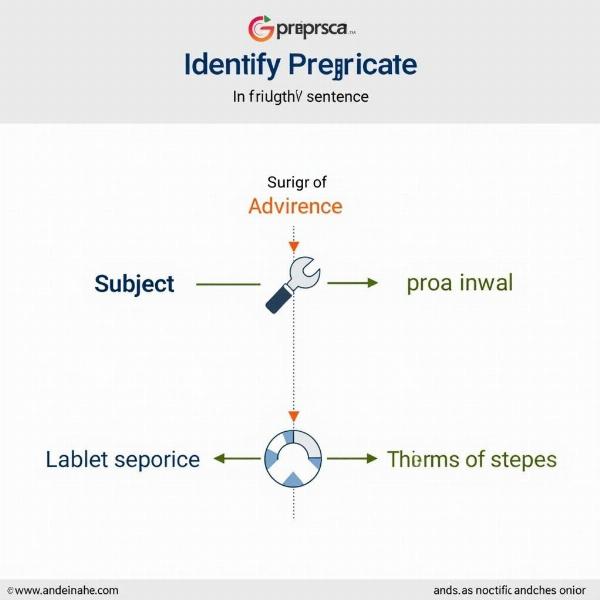Understanding the Hindi meaning of “predicate” is crucial for grasping the fundamentals of Hindi grammar and sentence structure. The predicate, simply put, is the part of a sentence that tells us something about the subject. It completes the thought expressed by the subject and often involves a verb, describing an action, state, or condition. Knowing how predicates work can enhance your Hindi comprehension and communication skills.
What is a Predicate in Hindi?
In Hindi, the predicate (विधेय – vidhey) is the part of the sentence that complements the subject (कर्ता – karta). It describes what the subject does, what happens to the subject, or what state the subject is in. The predicate always contains a verb (क्रिया – kriya) and may also include objects (कर्म – karm), complements (पूरक – purak), and adverbials (क्रियाविशेषण – kriyavisheshan). The subject introduces the topic, and the predicate expands on it. For example, in the sentence “राम खाता है” (Ram eats), “राम” (Ram) is the subject, and “खाता है” (eats) is the predicate.
Components of a Predicate
The core of a predicate is the verb. However, a predicate can be more complex and include other elements:
- Verb (क्रिया): This is the essential component, indicating action or state. Examples include जाना (jana – to go), खाना (khana – to eat), and होना (hona – to be).
- Object (कर्म): This is the entity that receives the action of the verb. For example, in “राम रोटी खाता है” (Ram eats bread), “रोटी” (bread) is the object.
- Complement (पूरक): This completes the meaning of the verb. For example, in “वह शिक्षक है” (He is a teacher), “शिक्षक” (teacher) is the complement.
- Adverbial (क्रियाविशेषण): These modify the verb, providing details about time, place, manner, etc. For example, in “वह धीरे-धीरे चलता है” (He walks slowly), “धीरे-धीरे” (slowly) is the adverbial.
Identifying the Predicate in a Hindi Sentence
Identifying the predicate involves first identifying the subject. Ask yourself, “Who or what is performing the action?” or “Who or what is being described?” The remaining part of the sentence, which answers these questions, is the predicate. This applies to simple as well as complex sentences.
 Identifying Hindi Predicates
Identifying Hindi Predicates
Importance of Understanding Predicates
Understanding predicates is fundamental to:
- Correct Sentence Construction: Knowing how predicates function helps you form grammatically correct and meaningful sentences in Hindi.
- Improved Comprehension: A clear understanding of predicates enhances your ability to understand the intended meaning of a sentence.
- Effective Communication: Using predicates correctly allows you to communicate your thoughts and ideas accurately and effectively.
Common Mistakes to Avoid
- Confusing the subject with the predicate: Remember that the subject is the doer or the one being described, while the predicate describes the action or state.
- Omitting the verb: A predicate must always contain a verb.
How does understanding “predicate” relate to other grammatical concepts?
Understanding the “predicate” is intertwined with understanding other grammatical concepts like subjects, objects, verbs, and sentence structure as a whole. It’s like a puzzle piece – it doesn’t make sense on its own but is crucial for completing the larger picture. predicate in hindi meaning is crucial to comprehending sentence structure.
Conclusion
The predicate, or vidhey in Hindi, forms a core part of a sentence, providing essential information about the subject. Mastering the concept of the predicate improves your Hindi grammar, comprehension, and communication skills. By understanding the different components of a predicate and how to identify it, you can construct well-formed sentences and communicate effectively in Hindi. Knowing the hindi meaning of predicate empowers you to dissect sentences and truly understand the nuances of the language.
FAQ
- What is the Hindi word for predicate? The Hindi word for predicate is विधेय (vidhey).
- Can a predicate exist without a verb? No, a predicate must always contain a verb.
- What is the difference between a subject and a predicate? The subject is who or what the sentence is about, while the predicate tells us something about the subject.
- Why is it important to understand predicates? Understanding predicates is crucial for correct sentence construction, improved comprehension, and effective communication.
- How can I identify the predicate in a complex sentence? Identify the subject first, and the remaining part of the sentence, which describes the subject, is the predicate.
- Does the predicate always follow the subject in a Hindi sentence? While typically the predicate follows the subject, in some cases, the order can be reversed for emphasis.
- Can a predicate contain more than one verb? Yes, a predicate can contain more than one verb, especially in complex sentences.
Meaning-Hindi.in is your one-stop solution for all your Hindi translation needs. We offer a range of professional translation services, including business and commercial document translation, certified and legal document translation, technical and user manual translation, website and localization translation, educational and academic document translation, 3 forms of verb with hindi meaning, even more meaning in hindi, and specialized translation. hai ka hindi meaning or predicated meaning in hindi? Contact us today at [email protected] or +91 11-4502-7584 for accurate and culturally sensitive translations. Meaning-Hindi.in is committed to providing high-quality language services to bridge the communication gap.